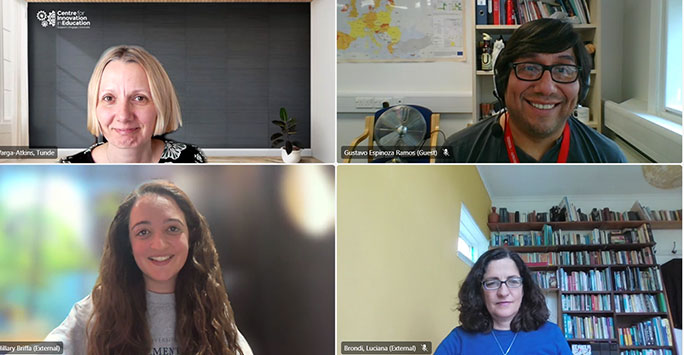Treasure Island Pedagogies: Episode 41, the one with the Headbands
Posted on: 6 June 2025 by Dr Tunde Varga-Atkins in General

In episode 41 of Treasure Island Pedagogies, Tünde Varga-Atkins welcomes Hilary Briffa, Luciana Brondi, and Gustavo Espinoza Ramos to share their teaching light bulb moments and creative classroom strategies—from gamified quizzes and drama-based learning to emotional connection and mock trials. They highlight how play, empathy, and student-led engagement foster deeper learning. The episode ends with each guest choosing a luxury item for the island—music, running shoes, and a stand-up comedy guide.
Speakers: Hillary Briffa, Luciana Brondi, Gustavo Espinoza Ramos
Date: 6 June 2025
Treasure Island Pedagogies: Episode 41 podcast
(Treasure Island Pedagogies Episode 41 - Podcast Transcript)
Read or listen to find out our guests’ lightbulb moments, teaching props, pedagogies and luxury items that they would take to their Treasure Islands for precious contact time with students.
Luciana Brondi
- Original discipline: Medicine and Infectious Diseases
- Current Role: Lecturer in Global Health and Development
- Lightbulb moment: Realizing that my patients, predominantly, were not simply getting ill because of their biomedical profile (including their genetic, anatomical and physiological issues). Rather, it was their economic, social, cultural and environmental conditions that were the main determinants of their illnesses and lack of well-being. And these broader determinants also affected their health outcomes once they any health issue.
- Teaching Prop or Pedagogy: The head bandz game, adapted for infectious diseases;
- Luxury Item: Running trainers or swimming suit and goggles. I will bring the head bandz game.
Gustavo Espinoza Ramos, University of Westminster, UK
- Original discipline: Sustainable Business, Business strategy
- Current Role: Senior lecturer
- Lightbulb moment: When using a Poll Everywhere competitions (gamification of learning) as a class assessment technique (CATs) to assess formative a posteriori knowledge.
- Teaching Prop or Pedagogy: Trying to remember students’ names as this will create an emotional connection with students that will represent the foundations to develop learning.
- Luxury item: A stand-up guide, so that everyone on the island will be able to develop storytelling techniques to us more in depth, create a stronger bond with others; make fun of ourselves; and find a way to share my story.
Hilary Briffa, King’s College London, UK
- Original discipline: International Relations, War Studies
- Current Role: Senior Lecturer in National Security Studies, Department of War Studies (Currently also pursuing a second doctorate in Higher Education at Lancaster University)
- Lightbulb moment: My lightbulb moment didn’t happen in a classroom—it happened on a plane. I was on a field trip with 100 students and ended up sitting next to one of them. He was the student who usually sat at the back of lectures, hoodie up, quiet and seemingly disengaged. But during that flight, I got to know him. He opened up about his struggles with adjusting to London life, balancing a job with his studies, and managing social anxiety. That conversation changed everything. Back in class, I was able to tailor discussions in a way that helped him engage. At the end of the year, he emailed me to thank me for creating a space where he felt safe enough to grow—academically and personally. It was a powerful reminder that some of the most meaningful learning moments happen quietly, and our job is to make room for them.
- Teaching Prop or Pedagogy:One of my go-to approaches is putting historical figures or concepts on trial. Whether it’s Bismarck, Machiavelli, or the liberal international order, I assign students roles—defence, prosecution, witnesses—and we hold a courtroom-style debate. It’s an engaging way to get students thinking critically, drawing on evidence, and exploring different perspectives. It also levels the playing field—students with different strengths can all find their moment to shine. Importantly, I always leave time for debriefing so we can connect the activity to both the content and the skills they’re building.
- Luxury item:I'd bring my headphones. Music is my go-to for decompressing. From indie rock to dubstep, it helps me reset and reflect. I’ve even thought about ways to incorporate music into my teaching—maybe creating course-themed playlists or letting students choose tracks that relate to weekly topics. Music connects people, and that’s what good education does too.
Any Sparks? How Might Our Joined-Up Treasure Islands Look Like?
What struck us during this conversation was how much our approaches, though different, complemented each other. We all believe in creating space—space to be seen, to play, to take risks, and to connect. On our collective Treasure Island, we’d start the day with Luciana’s physical warm-ups and drama games, move into Gustavo’s quizzes and name circles, hold one of Hilary’s intellectual trials under the palm trees, and finish with music and comedy under the stars. There’d be deep learning, plenty of laughter, and a shared commitment to making education more human.
Keywords: Treasure Island Pedagogies, Podcast, Innovation, Education, Drama in education, Gamification, active learning, Innovation, Inclusive teaching, Emotional connection.